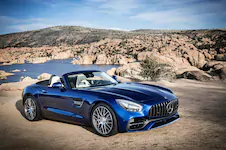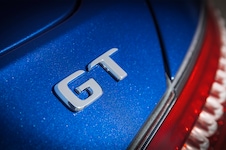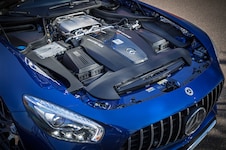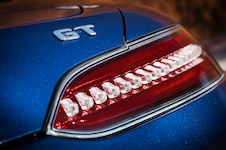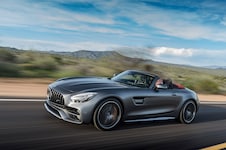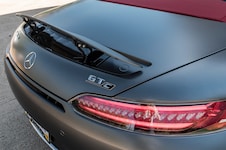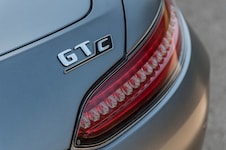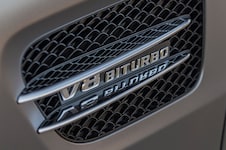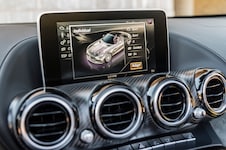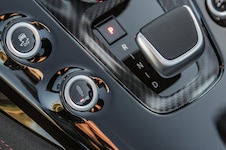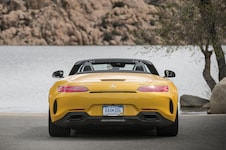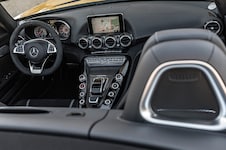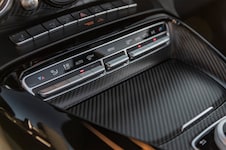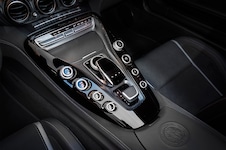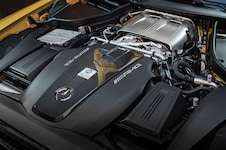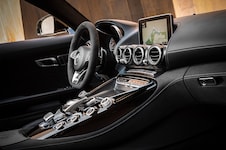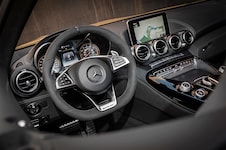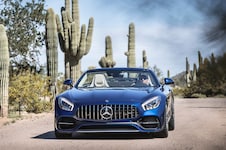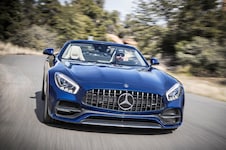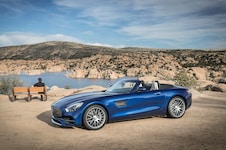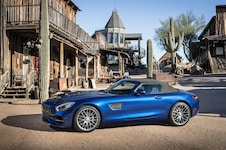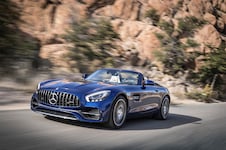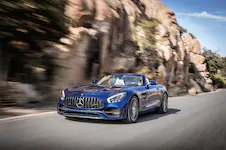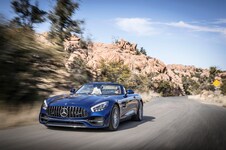A commentary on both the universal nature of music and its lasting power, “The Song Remains the Same” launched Led Zeppelin’s experimental, controversial, wildly successful, and now widely overlooked fifth album, Houses of the Holy. Virtuoso performances from Jimmy Page, John Paul Jones, and John Bonham combined with Page’s technical mastery in the studio for a tour-de-force performance only briefly interrupted by an oddly sped-up Robert Plant vocal track. In much the same way, the 2018 Mercedes-AMG GT Roadster and GT C Roadster put on a chart-topping performance let down by only minor points of contention.
As much as the song is a five-and-a-half-minute guitar solo punctuated by a surprising but refreshing down-tempo break, the GT Roadster and GT C Roadster are all hard-driving rock ’n’ roll with a healthy dose of civility at low speeds. As with their coupe brethren, the Roadsters are as much driver’s cars as they are grand tourers, and unlike Roadsters of old, no excuses need be made with the tops removed.
The beauty of modern computer-enhanced engineering is best observed in the quality of today’s convertibles, scarce though they may be. When a car is engineered from day one with a convertible variant in mind, as the AMG GT was, the chassis can be designed with enough support and rigidity so that removing as strong a structural member as the roof doesn’t turn steel pipe into a garden hose. As such, only a bit of bracing behind the dashboard and slightly beefier door sills were necessary. Even with all the convertible roof hardware, the Roadsters add only 77 to 110 pounds to the curb weights of their coupe counterparts.

Countering such minimal weight gain are commensurate additions of horsepower and torque. For the GT Roadster, 20 hp and 21 lb-ft; the GT C, 47 hp and 23 lb-ft. Total, the “base” GT Roadster commands 476 hp and 464 lb-ft, the GT C Roadster 550 hp and 502 lb-ft. Rather than mechanical enhancement, the Roadsters out-muscle their coupe counterparts with additional boost from the two turbos lurking in the valley of the 4.0-liter V-8. Mercedes-AMG, the semi-autonomous performance division of Mercedes-Benz wholly responsible for the development of the GT family, conservatively estimates zero to 60 mph times of 4.0 seconds for the GT Roadster and 3.7 seconds for the GT C Roadster. Coupes have done the same sprint in as little as 3.2 seconds in our hands, and we expect the more powerful and only slightly heavier convertibles to perform equally well.
Now would be a good time, before we continue, to clarify the GT’s naming strategy, as it’s confusing even for the professionals. Coupe models, in order of performance, are the GT, GT S, and GT R. Convertible models, in the same order, are the GT Roadster and GT C Roadster. Even more confusingly, there will eventually be a GT C coupe splitting the difference between the GT S coupe and GT R coupe.
The Roadsters aren’t just enhanced with raw power, though. Each borrows tricks from the track-focused GT R coupe, with a 2.2-inch-wider rear end housing wider wheels and tires. Other standard carryovers include the GT R’s slotted grille and shutters behind it, which open for cooling as needed but are otherwise closed for aerodynamic improvements. The GT C Roadster also lifts the GT R’s electronically controlled limited-slip differential and rear-wheel steering, but the GT Roadster makes due with a mechanical limited-slip. Other enhancements justifying the GT C Roadster’s price premium (a $20,000 differential on coupes) include adaptive dampers, a standard performance exhaust, and a Race driving mode for track duty (yes, in a convertible). Driver-adjustable dampers are standard on the GT Roadster, and the performance exhaust is an option. Both car can be equipped with carbon-ceramic brakes.
The pertinent question is whether the upgrades are worth the cost, and the answer is yes. The additional horsepower alone transforms the car from quick to impressively quick. The GT Roadster is no slouch, but its straight-line demeanor is more relaxed than the GT C Roadster’s. The surge at wide-open throttle is healthy but feels more sports car than supercar. In Comfort mode, it’s preceded by an unfortunate combination of turbo lag and transmission lag, needing a beat to drop the gears and spin up the turbos. Sport and Sport+ modes cure these ills handily, although Sport+ overdoes it with the throttle sensitivity. Sport is the pre-programmed sweet spot if you can’t be bothered to set up the Individual mode profile. The GT C Roadster, by contrast, suffers no delays and pulls with the ferocity its exotic body promises, even in Comfort. When properly engaged, the dual-clutch transmission continues to deliver lightning-quick and perfectly timed shifts so well you won’t find yourself reaching for the paddle shifters out of necessity.
Equally palpable is the difference in handling. The GT Roadster feels like a large car on a back road, something the GT S coupe never did. The steering is just as quick and lively as the coupe’s, but the car just doesn’t feel as playful. The GT C Roadster, with its trick differential and rear steer, fix this quite expertly. Its rear wheels turning slightly opposite up to 62 mph and in the same direction above, the GT C Roadster darts into corners with an eagerness the GT Roadster simply can’t match. This car feels every bit like the GT S coupe that won our Best Driver’s Car award its first year out. It’s nimble, it’s lithe, and it’s responsive. It’s easy to drive fast.

The GT C Roadster is eager enough to disguise a change in damping philosophy obvious on the GT Roadster. Where the GT S coupe allows for a bit of dive, squat, and roll of the body, the Roadsters corner very, very flatly. Although the buttoned-down suspension might improve lap times, it robs the car of some of the character that endeared us to the GT S coupe. The coupe could’ve handled flatter, but its measured, controlled motions reminded us of a 500-hp Miata and more deeply engaged us in the driving experience. A bit more spirit wouldn’t hurt the Roadsters at all.
The GT C Roadster might be the more exciting, engaging twin, but the two are otherwise consistent in both strengths and weaknesses. The most obvious strength is literal, as neither car showed a hint of chassis flex or cowl shake with its roof down. Both raise or lower said roof in an impressive 11 seconds at speeds up to 30 mph, and both are reasonably quiet inside with it up. Roof down, the clear wind deflector between the seats does little to preserve your hairstyle.
The cockpit is likewise the stage for a few missteps. Where one would expect removing the roof would improve visibility, it’s a very small improvement in this case. Over-the-shoulder visibility is better with the roof down, but the high window line remains difficult to see over. Rear visibility is even worse than the coupes, as the folded roof creates a large hump on the rear of the car. Use the mirrors and rearview camera, as there’s no use trying to crane your neck over it. You could jack up the seat, so long as you remember to lower it before closing the roof. Turning your head to look behind also puts you face to face with a wall, which Mercedes-AMG has strangely chosen not to decorate with anything more than the same carpeting as the floors. No additional storage, no trim, just a blank swatch of office flooring.
Even if you don’t turn back, you’ll be doing some moving around in the seats. The seat bottoms are very firm and quickly become uncomfortable, and there aren’t a lot of options for shifting your weight around, as the bolsters are very large for track driving. They’re great sport seats, no question, but for a touring car, they’re too aggressive, and most drivers won’t spend much time at the track. An optional comfort seat would be wise.
There’s also the matter of the trunk, though you’ve no doubt already guessed it’s small. The roof has to go somewhere when it’s folded. Thankfully, it’s far from the smallest convertible trunk on the market and is just big enough to handle two carry-on bags.
Common convertible compromises aside, the GT Roadster and GT C Roadster perform remarkably consistently with their fixed-roof counterparts. Like Houses of the Holy, they put on a dazzling performance and are sure to be a sales success. Unlike that album, though, don’t expect them to be overlooked by the collectors and connoisseurs of the future.


